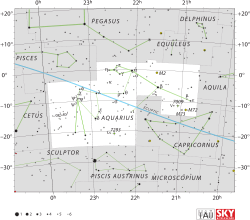Phi Aquarii
 | |
| Observation data Epoch J2000 Equinox J2000 | |
|---|---|
| Constellation | Aquarius |
| Right ascension | 23h 14m 19.35787s[1] |
| Declination | –06° 02′ 56.3998″[1] |
| Apparent magnitude (V) | +4.223[2] |
| Characteristics | |
| Spectral type | M1.5 III[3] |
| U−B color index | +1.897[2] |
| B−V color index | +1.563[2] |
| Astrometry | |
| Radial velocity (Rv) | +2.48 ± 0.32[4] km/s |
| Proper motion (μ) | RA: +43.12[1] mas/yr Dec.: –194.45[1] mas/yr |
| Parallax (π) | 16.14 ± 0.89[1] mas |
| Distance | 200 ± 10 ly (62 ± 3 pc) |
| Absolute magnitude (MV) | 0.30±0.120[5] |
| Details | |
| Mass | 1.00±0.03[6] M☉ |
| Radius | 34.77+1.83 −2.04[6] R☉ |
| Luminosity | 207.7±25.2[6] L☉ |
| Surface gravity (log g) | 1.5[4] cgs |
| Temperature | 3715±48[6] K |
| Rotational velocity (v sin i) | 6.7[4] km/s |
| Age | 10.97±0.83[6] Gyr |
| Other designations | |
| Database references | |
| SIMBAD | data |
Phi Aquarii (φ Aqr, φ Aquarii) is the Bayer designation for a binary star[8] system in the equatorial constellation of Aquarius. It is visible to the naked eye with an apparent visual magnitude of +4.223.[2] Parallax measurements from the Hipparcos mission indicate its estimated distance from Earth is roughly 220 light-years (67 parsecs).[1]
This is a spectroscopic binary star system with an estimated period of 2,500 days.[9] The primary component is a red giant star with a stellar classification of M1.5 III.[3] The outer envelope of this evolved star has expanded to 35 times the size of the Sun. It is radiating 208 times the luminosity of the Sun at an effective temperature of 3,715 K,[6] giving it the reddish hue of an M-type star.[10]
References
- 1 2 3 4 5 6 van Leeuwen, F. (November 2007), "Validation of the new Hipparcos reduction", Astronomy and Astrophysics, 474 (2): 653–664, arXiv:0708.1752, Bibcode:2007A&A...474..653V, doi:10.1051/0004-6361:20078357.
- 1 2 3 4 Gutierrez-Moreno, Adelina; et al. (1966), A System of photometric standards, 1, Publicaciones Universidad de Chile, Department de Astronomy, pp. 1–17, Bibcode:1966PDAUC...1....1G.
- 1 2 Morgan, W. W.; Keenan, P. C. (1973), "Spectral Classification", Annual Review of Astronomy and Astrophysics, 11: 29, Bibcode:1973ARA&A..11...29M, doi:10.1146/annurev.aa.11.090173.000333.
- 1 2 3 Massarotti, Alessandro; et al. (January 2008), "Rotational and Radial Velocities for a Sample of 761 HIPPARCOS Giants and the Role of Binarity", The Astronomical Journal, 135 (1): 209–231, Bibcode:2008AJ....135..209M, doi:10.1088/0004-6256/135/1/209.
- ↑ Park, Sunkyung; et al. (2013), "Wilson-Bappu Effect: Extended to Surface Gravity", The Astronomical Journal, 146 (4): 73, arXiv:1307.0592, Bibcode:2013AJ....146...73P, doi:10.1088/0004-6256/146/4/73.
- 1 2 3 4 5 6 Baines, Ellyn K.; et al. (2018). "Fundamental Parameters of 87 Stars from the Navy Precision Optical Interferometer". The Astronomical Journal. 155. 30. arXiv:1712.08109. Bibcode:2018AJ....155...30B. doi:10.3847/1538-3881/aa9d8b.
- ↑ "* phi Aqr". SIMBAD. Centre de données astronomiques de Strasbourg. Retrieved 2012-07-05.
- ↑ Eggleton, P. P.; Tokovinin, A. A. (September 2008), "A catalogue of multiplicity among bright stellar systems", Monthly Notices of the Royal Astronomical Society, 389 (2): 869–879, arXiv:0806.2878, Bibcode:2008MNRAS.389..869E, doi:10.1111/j.1365-2966.2008.13596.x.
- ↑ Famaey, B.; et al. (May 2009), "Spectroscopic binaries among Hipparcos M giants,. I. Data, orbits, and intrinsic variations", Astronomy and Astrophysics, 498 (2): 627–640, arXiv:0901.0934, Bibcode:2009A&A...498..627F, doi:10.1051/0004-6361/200810698.
- ↑ "The Colour of Stars", Australia Telescope, Outreach and Education, Commonwealth Scientific and Industrial Research Organisation, December 21, 2004, retrieved 2012-07-02.
External links
This article is issued from
Wikipedia.
The text is licensed under Creative Commons - Attribution - Sharealike.
Additional terms may apply for the media files.